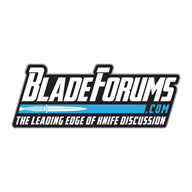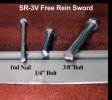Did the Busses cut their own branch by introducing SR-3V?
I am just throwing the grenade here and waiting for the avalanche of replies.
I found this thread, which was created before SR-3V:
I thought it is a good moment to bring this conversation here.
My thoughts:
1. My personal experience
I have been using INFI for about 18 years, had 3 knives in it, one of which has been used a lot. It had also been my primary knife at some point in the past (not anymore). I am using a Free Rein Wakizashi in SR-3V for about 6 months now. For short: SR-3V has visibly better edge retention. INFI has slightly better corrosion resistance. SR-3V has higher hardness and a more stable edge. SR-3V is significantly harder to sharpen. Although the grinds are different, the edge itself has very similar angle between my blades, so I think the comparation is consistent. I haven't noticed any difference in toughness, but that may be due to the fact I haven't exposed my Free Rein to the hard use enough yet. My INFI blade has hit rocks and ground multiple times in the past. That resulted in minor stamps onto the edge which proved high ductility. My SR-3V blade has only hit a tree that had steel wire under its bark, twice. That resulted in 2 dings onto the edge, which also appeared as stamps, not chips.
2. Politics
I think that introducing a form of CPM-3V at Swamp Rat was an important and necessary move, regardless of whether this steel was good or bad. There were a lot of debates in the public space about whether 3V is better than INFI. Jerry has publicly responded, but... Saying that the steel you use is better than the steels of others is common in marketing and not credible from a manufacturer. It is significantly more credible to say: "We can give you both INFI and 3V (and our 3V is better than other's); it's up to you to decide which one, the profit for us being the same regardless what you choose; but we still consider INFI to be the best".
3. My own preference
I like INFI a lot. It is a dream of a steel. But instead of going too much into subjective interpretations, let's answer some straightforward questions:
3.1. What would be the reason to prefer INFI over something that brings similar toughness, flexibility, and corrosion resistance, but at a much higher hardnesshas and with higher wear resistance? In the past, the company was proud to claim that they could bend a Battle Mistress at 45 degrees and it sprung back to true. Now the youtube channel of the Busse Company Group shows a SR Free Rein Wakizashi bending to 90 degrees and it springs back to true; then it bends to 180 degrees without breaking - and all that at 62 HRC. Can any blade in INFI reproduce that at that hardness? Can any INFI blade reproduce the bolt cut test and still cut paper after?
3.2. If INFI is better than SR-3V, then why don't we see it used in big blades at hardnesses over 60? I have seen INFI beyond 60 HRC in small blades only. That applies to the entire industry, so INFI seems in the chart with all the rest of the industry: I have seen powder steels at 61-63 HRC in small blades only and not in large choppers. Even the likes of Carothers - who have exceptional heat treatment, don't bring their big blades beyond 60.5 HRC. SR-3V is crazy unique in that regards! You may find some katana blades in Japan that have that hardness and still resist impacts, but with differential treatment and a manufacturing process that cost a fortune. With SR-3V I can hold in my own hand a 23 inches big chopper having a hardness of HRC 62 (+-1) and that dubbed by a lifetime warranty that covers also damage (not only manufacturing defects). Oh, wait, there is an upcomimg 28 inches one, at the same 61-63 HRC hardness. Can INFI withstand heavy use in such a long chopper, with such a thin and narrow blade, at such a high hardness?
3.3. In the past, Jerry stated that there is no steel in the world that could equal the performance of SR-101, except for INFI. I wonder how would he rephrase that one, in the context of SR-3V.
There is, for sure, information usable to measure durability and compare the two steels in an objective matter. For example: the percentage, out of the totally sold knives, that fail and go back under warranty (how does this number compare between SR-3V and INFI?). But I doubt that anyone inside the company would share such numbers onto a public forum.
Waiting with passion for replies.
PS: I hope I won't be banned for opening this thread.
I am just throwing the grenade here and waiting for the avalanche of replies.
I found this thread, which was created before SR-3V:
I thought it is a good moment to bring this conversation here.
My thoughts:
1. My personal experience
I have been using INFI for about 18 years, had 3 knives in it, one of which has been used a lot. It had also been my primary knife at some point in the past (not anymore). I am using a Free Rein Wakizashi in SR-3V for about 6 months now. For short: SR-3V has visibly better edge retention. INFI has slightly better corrosion resistance. SR-3V has higher hardness and a more stable edge. SR-3V is significantly harder to sharpen. Although the grinds are different, the edge itself has very similar angle between my blades, so I think the comparation is consistent. I haven't noticed any difference in toughness, but that may be due to the fact I haven't exposed my Free Rein to the hard use enough yet. My INFI blade has hit rocks and ground multiple times in the past. That resulted in minor stamps onto the edge which proved high ductility. My SR-3V blade has only hit a tree that had steel wire under its bark, twice. That resulted in 2 dings onto the edge, which also appeared as stamps, not chips.
2. Politics
I think that introducing a form of CPM-3V at Swamp Rat was an important and necessary move, regardless of whether this steel was good or bad. There were a lot of debates in the public space about whether 3V is better than INFI. Jerry has publicly responded, but... Saying that the steel you use is better than the steels of others is common in marketing and not credible from a manufacturer. It is significantly more credible to say: "We can give you both INFI and 3V (and our 3V is better than other's); it's up to you to decide which one, the profit for us being the same regardless what you choose; but we still consider INFI to be the best".
3. My own preference
I like INFI a lot. It is a dream of a steel. But instead of going too much into subjective interpretations, let's answer some straightforward questions:
3.1. What would be the reason to prefer INFI over something that brings similar toughness, flexibility, and corrosion resistance, but at a much higher hardnesshas and with higher wear resistance? In the past, the company was proud to claim that they could bend a Battle Mistress at 45 degrees and it sprung back to true. Now the youtube channel of the Busse Company Group shows a SR Free Rein Wakizashi bending to 90 degrees and it springs back to true; then it bends to 180 degrees without breaking - and all that at 62 HRC. Can any blade in INFI reproduce that at that hardness? Can any INFI blade reproduce the bolt cut test and still cut paper after?
3.2. If INFI is better than SR-3V, then why don't we see it used in big blades at hardnesses over 60? I have seen INFI beyond 60 HRC in small blades only. That applies to the entire industry, so INFI seems in the chart with all the rest of the industry: I have seen powder steels at 61-63 HRC in small blades only and not in large choppers. Even the likes of Carothers - who have exceptional heat treatment, don't bring their big blades beyond 60.5 HRC. SR-3V is crazy unique in that regards! You may find some katana blades in Japan that have that hardness and still resist impacts, but with differential treatment and a manufacturing process that cost a fortune. With SR-3V I can hold in my own hand a 23 inches big chopper having a hardness of HRC 62 (+-1) and that dubbed by a lifetime warranty that covers also damage (not only manufacturing defects). Oh, wait, there is an upcomimg 28 inches one, at the same 61-63 HRC hardness. Can INFI withstand heavy use in such a long chopper, with such a thin and narrow blade, at such a high hardness?
3.3. In the past, Jerry stated that there is no steel in the world that could equal the performance of SR-101, except for INFI. I wonder how would he rephrase that one, in the context of SR-3V.
There is, for sure, information usable to measure durability and compare the two steels in an objective matter. For example: the percentage, out of the totally sold knives, that fail and go back under warranty (how does this number compare between SR-3V and INFI?). But I doubt that anyone inside the company would share such numbers onto a public forum.
Waiting with passion for replies.
PS: I hope I won't be banned for opening this thread.


